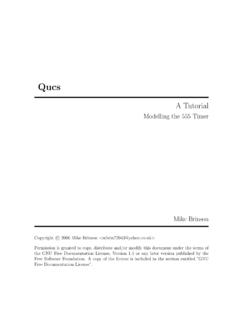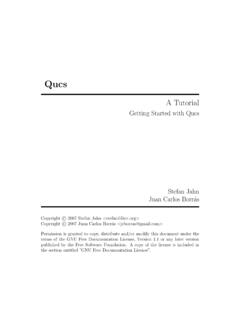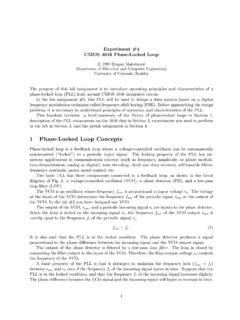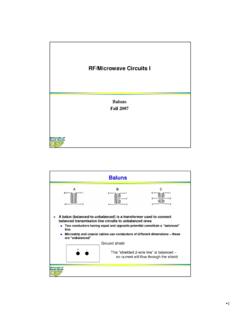Transcription of ADS Tutorial Stability and Gain Circles ECE145A/218A
1 ADS Tutorial Stability and gain Circles ECE145A/218A The examples in this Tutorial can be downloaded from ~long/ ece145a as the file: The first step in designing the amplifier with the S parameter method is to determine whether the transistor is unconditionally stable or potentially unstable. This can be easily estimated using the K Stability factor and delta. The amplifier will be unconditionally stable if: K > 1 and mag( ) < 1. These factors are easily calculated using Measurement Equations in the ADS schematic panel. K is pre-programmed in as StabFact which can be selected from the S-parameter palette on the left. Delta can be programmed yourself using a blank MeasEqn. The maximum available gain (MAG) and maximum stable gain (MSG) can also be calculated using the MaxGain function. When swept over a range of frequencies, it can be clearly seen where the device will be unconditionally stable (above GHz for this example).
2 Note that the user-defined equation capability of the display panel can be used to also calculate and plot MSG and the intrinsic transducer gain , Gti, the transducer gain when both S and L = 0. In the regions where K < 1, the max_gain function plots MSG. When unconditionally stable, it plots MAG. 11/9/2004 1 ADS tip: When you want to plot from your user-defined equations, you need to select the equations dataset in the plotting panel. Equations MSG MAGU nstable Next, you could check (as the book suggests) to see if the device is unilateral. (this is rarely the case). Evaluate the Unilateral Figure of Merit, U, at the design frequency using a Measurement Equation. Let s choose 500 MHz for our example. Show the result in a table in the display panel. 11/9/2004 2 Here, we see that at 500 MHz, the device is clearly not unilateral. The unilateral approximation would have an error of over 1 dB.
3 Bilateral design. If the device is unconditionally stable at the design frequency, then the input and output can be conjugately matched as shown in Section of Gonzalez (and Sect. of Pozar) and the maximum available gain can be obtained. MS and ML can be determined uniquely. The input and output VSWR would = 1 in this case. This would be applicable for this device in the region where K > 1. The conjugate match reflection coefficients can be calculated on ADS using the Smgam1 and Smgam2 measurement equation icons in the S-parameter palette. However, at 500 MHz, we find that K = We must take into account Stability as well as gain . It is wise to design the amplifier for less than the maximum stable gain , MSG, to allow margin for Stability . We have 2 choices on how to proceed with the design. 1. We could continue with the design for a bilateral amplifier if the source and load plane Stability Circles do not contain S or L.
4 This is possible only if we can meet the required gain specifications while still avoiding the unstable regions. 2. We could add stabilization resistors to the device to force unconditional Stability . Then, we would be less constrained in our choices of S or L, but if we over-stabilize the device, we may again find that we can t meet the required gain specifications. So, let s look at the device first for Stability . Stability Circles should be calculated. This is done by using the LStabCircle and SStabCircle functions. 11/9/2004 3 Examining the Stability Circles , we see that it would be relatively easy to resistively stabilize this transistor and make it unconditionally stable at 500 MHz. A series resistance of (50) = 9 at the input or a shunt resistor of 1/( * ) = 430 at the output will push the source or load Circles outside the Smith chart at this frequency.
5 Of course, after designing the matching networks, we must check the amplifier later over a wider frequency range for Stability . We might need to modify the stabilization approach, but if resistance is included in the matching network appropriately, it is often possible to improve Stability without sacrificing gain at the design So, let s take approach #2 and see how effective a shunt 430 ohm resistor on the output of the transistor will be. From the figure below, we see that it provides Stability on the load plane and nearly unconditional Stability on the source plane (again, remember, this is at a single frequency). 11/9/2004 4 Now, we can proceed with designing the input and output matching networks. In the bilateral case, we need a systematic design method, because changes in S will affect OUT and changes in L will affect IN. L is the load reflection coefficient presented to the device.
6 The operating power gain , GP, provides a graphical design method suitable for bilateral amplifiers. gain Circles can be calculated that show contours of constant operating power gain . GP is useful since it is independent of the source impedance; the gain circle represents the gain that would be obtained if a magic genie adjusted S = IN* for each value of L on the circle . Then, GP = GT, ie. the operating power gain equals the transducer gain . I have found it more convenient to calculate the operating power gain Circles on the data display rather than on the schematic. On the data display, you can change the gain values without having to re-simulate the amplifier. Use the Eqn function to write gain circle equations. The syntax is: gp_circle(S, gain , # points on circle ) where S is the S-parameter matrix. Let s illustrate. In the example below, a table is used to display frequency, maximum stable gain (MSG), the Stability factor, k, and the magnitude of delta.
7 The gain Circles are at MSG (MaxGain1 in this case), and 1 and 2 dB below MSG. A marker is placed on the 2 dB circle . L can be read off the display as magnitude = with angle = degrees. If the input is conjugately matched (and stable), then the gain should be MSG 2 = dB. The load Stability circle is also shown. The load impedance can be chosen away from this circle to maximize Stability . We see that k < 1, but not significantly so. 11/9/2004 5 Next, calculate the input reflection coefficient for your choice of L and make sure it is stable. To do this, plot the source plane Stability circle and compare with S. We can see that this choice will be stable at the design frequency. 11/9/2004 6 Biasing and matching network design. The next step in designing the amplifier will be the implementation of the input and output matching networks such that they provide reflection coefficients S and L as determined above.
8 This can be done using the Smith chart. In general, there may be several solutions possible using lumped or distributed L networks. In selecting a design, you need to consider how you will bias the amplifier. You have 2 choices: bias with RF chokes and blocking capacitors or bias through the matching network elements. biasing example Consider the load plane. 11/9/2004 7 The marker is on the 2 dB operating power gain circle and represents our choice of L. Notice that we have many options for L as long as we keep a respectable distance from the load Stability circle . As shown above, if we choose L at the location of m1, we are nearly on the unit constant resistance circle (r=1). Adding an inductance (red arrow) in series with the 50 ohm load will place us at L. The series inductance could be implemented with a lumped inductor (if feasible) or a series transmission line of high impedance.
9 This approach will require an RFC or a /4 high Zo line for biasing. Alternately, a series shunt matching network could be used. This approach is shown in blue arrows. A series 50 ohm transmission line connects the collector to a shunt shorted stub or an inductor. This stub can also serve as our bias port if we are careful to provide appropriate bypass capacitance for the power supply and DC blocking where needed. We can use the same idea for the source plane: add shunt inductance, moving up the g=1 circle . Then add a series 50 ohm transmission line until you reach S. This is the impedance that must be provided to the input to match IN. 11/9/2004 8 The complete circuit looks like this: Checking the results, we find that it does meet the expected gain of 20 dB but is potentially unstable at frequencies below 500 MHz. Note that the capacitors needed for bypassing and DC blocking have been modeled with equivalent networks.
10 The DC blocking capacitors at the input and output have been designed to be series-resonant at the operating frequency. Further improvements in accuracy for design purposes could be obtained by using the MLIN microstrip physical line models with bends and tees as needed. When RF chokes are used for biasing instead 11/9/2004 9of the matching network approach, you should model the RFC as an equivalent RLC network and determine Stability of the amplifier over a wide frequency range as well. If you want to have a successful design on the first attempt, you must include equivalent circuit models for all of the components which will sensitively affect the performance. Wideband Stability . We must also guarantee that the amplifier is stable not only at the design frequency but everywhere else as well. To do this, we will sweep the frequency over a wide range (100 MHz to 1 GHz) and look at k, S11 and S22.











